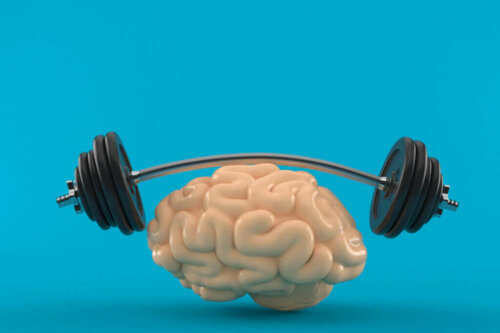Causes and Treatments of Knee Osteoarthritis

On a daily basis, the structures of the body wear out. Most of these tissues regenerate, but over time, it becomes harder for the body to do this. In fact, knee osteoarthritis is an example of this.
Next, we’ll look at everything about this pathology. Although there isn’t a cure, you can live a normal life. What is it, how does it appear, what are the treatments, and what symptoms does it present? We’re going to answer all of these questions and more.
What is knee osteoarthritis?
Like any other arthritis, knee osteoarthritis is a degenerative process that involves inflammation. Being osteoarthritis, we’re talking about a pathology where the cartilage that protects the bones wears out. Therefore, the bone rubs against other structures, causing pain and inflammation.
Of all of this type of pathology, knee osteoarthritis is the most common. This is due to the constant load that this joint sustains from when we began walking.
The cartilage that protects the end of the femur regenerates when we’re younger. However, over the years, this capacity diminishes. Also, if you don’t take care of certain aspects, you can end up with this condition.
Causes and symptoms
As we’ve seen, there are two main causes of this pathology. On one hand, we use the knee joints very frequently in our lives. For example, a job where you have to squat or carry heavy weights will predispose you to it. On the other hand, age, which reduces the ability to regenerate damaged tissue.

Apart from these two factors, there are a few more that can accelerate the onset of this pathology. In this category we have:
- Overweight: if you’re carrying a lot of extra weight it can be damaging, according to research published by the International Journal of Obesity.
- Genetic factors: another factor lies with causes that are beyond our control. In fact, there are certain genes that predispose you to suffer from this pathology. Also included in this section are the deformities that someone might have due to abnormal bone growth. The bone may grow pathologically, or there may be less cartilage.
- Injury: If you’ve suffered knee injuries throughout your life, they probably affected the cartilage. Whether we’re talking about temporary pathologies or others that have required surgery, they all increase the risk of suffering from osteoarthritis.
Symptoms
The main symptoms of knee osteoarthritis are pain and limited mobility. The pain will be greater in the morning and when exercising.
On the other hand, there will also be stiffness in the joint, there will be some swelling from the inflammation and small pieces of bone may appear in the form of lumps. These are called osteophytes, and the body uses these to try and protect the joint. However, they end up being harmful.
Treatment for knee osteoarthritis
Unfortunately, there’s no cure for knee osteoarthritis, according to a study published by Rheumatic Disease Clinics of North America. It’s a disease that worsens over time, so the sooner it’s diagnosed, the more control you’ll have over the symptoms. However, you’ll never have a perfectly healthy knee as before. That said, if you catch it in time and take care of certain aspects, this condition won’t prevent you from leading a normal life.
The first thing to do is control your weight. If you’re overweight, you need to reach a healthy weight to avoid adding extra stress to the joint.
Also, it’ll help to do low-impact exercises such as walking, water aerobics or swimming, cycling, or using the elliptical at the gym. In this way, the muscles will be strong and will help to support the weight of the joint.

Another great alternative is going to a physical therapist who will give you specific stretches and strengthening exercises that don’t put stress on the knee. Knowing when to apply hot or cold will also be important.
If all of this isn’t enough, there are surgeries that improve symptoms, as well as medications that can help. Of course, a doctor must recommend this.
Constant diagnosis and treatment
As we can see, knee osteoarthritis is a pathology where the most important factor is prevention. Second, it’ll be necessary to detect it as soon as possible by visiting a doctor and getting the tests you need.
Finally, make sure you take care of yourself to prevent the symptoms from getting worse over time. If you do, even if you have this condition, you can age without losing too much mobility.
On a daily basis, the structures of the body wear out. Most of these tissues regenerate, but over time, it becomes harder for the body to do this. In fact, knee osteoarthritis is an example of this.
Next, we’ll look at everything about this pathology. Although there isn’t a cure, you can live a normal life. What is it, how does it appear, what are the treatments, and what symptoms does it present? We’re going to answer all of these questions and more.
What is knee osteoarthritis?
Like any other arthritis, knee osteoarthritis is a degenerative process that involves inflammation. Being osteoarthritis, we’re talking about a pathology where the cartilage that protects the bones wears out. Therefore, the bone rubs against other structures, causing pain and inflammation.
Of all of this type of pathology, knee osteoarthritis is the most common. This is due to the constant load that this joint sustains from when we began walking.
The cartilage that protects the end of the femur regenerates when we’re younger. However, over the years, this capacity diminishes. Also, if you don’t take care of certain aspects, you can end up with this condition.
Causes and symptoms
As we’ve seen, there are two main causes of this pathology. On one hand, we use the knee joints very frequently in our lives. For example, a job where you have to squat or carry heavy weights will predispose you to it. On the other hand, age, which reduces the ability to regenerate damaged tissue.

Apart from these two factors, there are a few more that can accelerate the onset of this pathology. In this category we have:
- Overweight: if you’re carrying a lot of extra weight it can be damaging, according to research published by the International Journal of Obesity.
- Genetic factors: another factor lies with causes that are beyond our control. In fact, there are certain genes that predispose you to suffer from this pathology. Also included in this section are the deformities that someone might have due to abnormal bone growth. The bone may grow pathologically, or there may be less cartilage.
- Injury: If you’ve suffered knee injuries throughout your life, they probably affected the cartilage. Whether we’re talking about temporary pathologies or others that have required surgery, they all increase the risk of suffering from osteoarthritis.
Symptoms
The main symptoms of knee osteoarthritis are pain and limited mobility. The pain will be greater in the morning and when exercising.
On the other hand, there will also be stiffness in the joint, there will be some swelling from the inflammation and small pieces of bone may appear in the form of lumps. These are called osteophytes, and the body uses these to try and protect the joint. However, they end up being harmful.
Treatment for knee osteoarthritis
Unfortunately, there’s no cure for knee osteoarthritis, according to a study published by Rheumatic Disease Clinics of North America. It’s a disease that worsens over time, so the sooner it’s diagnosed, the more control you’ll have over the symptoms. However, you’ll never have a perfectly healthy knee as before. That said, if you catch it in time and take care of certain aspects, this condition won’t prevent you from leading a normal life.
The first thing to do is control your weight. If you’re overweight, you need to reach a healthy weight to avoid adding extra stress to the joint.
Also, it’ll help to do low-impact exercises such as walking, water aerobics or swimming, cycling, or using the elliptical at the gym. In this way, the muscles will be strong and will help to support the weight of the joint.

Another great alternative is going to a physical therapist who will give you specific stretches and strengthening exercises that don’t put stress on the knee. Knowing when to apply hot or cold will also be important.
If all of this isn’t enough, there are surgeries that improve symptoms, as well as medications that can help. Of course, a doctor must recommend this.
Constant diagnosis and treatment
As we can see, knee osteoarthritis is a pathology where the most important factor is prevention. Second, it’ll be necessary to detect it as soon as possible by visiting a doctor and getting the tests you need.
Finally, make sure you take care of yourself to prevent the symptoms from getting worse over time. If you do, even if you have this condition, you can age without losing too much mobility.
All cited sources were thoroughly reviewed by our team to ensure their quality, reliability, currency, and validity. The bibliography of this article was considered reliable and of academic or scientific accuracy.
- K. Brandt, P. Dieppe y E. Radin. Etiopathogenesis of Osteoarthritis.Rheumatic Disease Clinics of North America. Volume 34, Issue 3, Pages 531-559 (2008)
- D. Coggon, I. Reading, P. Croft et al. Knee osteoarthritis and obesity. International Journal of Obesity. Volume 25, Pages 622–627 (2001)
- C. Bonnet y D. Walsh. Osteoarthritis, angiogenesis and inflammation, Rheumatology, Volume 44, Issue 1, Pages 7–16 (2005)
This text is provided for informational purposes only and does not replace consultation with a professional. If in doubt, consult your specialist.








